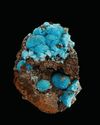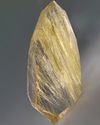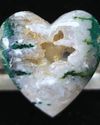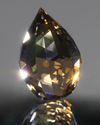
Titanium dioxide, better known as “titanium white,” originates, oddly enough, with the black mineral ilmenite.
Named for its type locality in the Ilmen Mountains of Russia’s southern Urals, ilmenite is iron titanium oxide (FeTiO3 ). An abundant mineral that crystallizes in the trigonal system, ilmenite usually occurs in massive or granular forms and occasionally as the tabular crystals sought by mineral collectors. Black, opaque, weakly magnetic, and exhibiting a metallic-to-submetallic luster, ilmenite has a Mohs hardness of 5.5-6.0 and a substantial specific gravity of 4.7-4.8.
As one of the first minerals to crystallize from solidifying magma, ilmenite’s density enables it to concentrate in layers at the bottom of magma chambers through the process of magmatic segregation. Solidification usually produces igneous masses with ilmenite-enriched layers. Then, as the host rock eventually weathers and erodes, the freed ilmenite particles concentrate in alluvial deposits. Placer miners know that the black sands in gold-pan and sluice concen-trates often consist largely of ilmenite.
Denne historien er fra January 2021-utgaven av Rock&Gem Magazine.
Start din 7-dagers gratis prøveperiode på Magzter GOLD for å få tilgang til tusenvis av utvalgte premiumhistorier og 9000+ magasiner og aviser.
Allerede abonnent ? Logg på
Denne historien er fra January 2021-utgaven av Rock&Gem Magazine.
Start din 7-dagers gratis prøveperiode på Magzter GOLD for å få tilgang til tusenvis av utvalgte premiumhistorier og 9000+ magasiner og aviser.
Allerede abonnent? Logg på

THE BRIGHT SIDE OF VOLCANIC ROCK
As a mineral resource, volcanic rock is decidedly short on glamour.

The Other Copper Minerals
12 Lesser-known Collectible Species

MINERAL COLLECTING -AND ROCK & GEM
Evolving Together FOR 54 YEARS

Gemstone Trends
A Look Back at 2024 & What to Expect in 2025

How to Make a GEM BEAD NECKLACE
No Lapidary Experience Needed!

Framing Nature's Art
Faceting Rutilated Quartz for Beginners

BEDAZZLED BLUE SEAM AGATE
More than several centuries ago, mining was the profession most often seen as befitting of men.

ROCK & GEM FIELD GUIDE:
Spinel is a captivating gemstone with a rich history of being mistaken for gems like ruby and sapphire.

SNAKE SCALE DROP 1.5:1
This Faceting Focus is revisiting the briolette gemstone design because of its popularity with independent and hobby gemstone faceters.

STONE CHIC
How Earth-Inspired Decor Brings Comfort to our Home